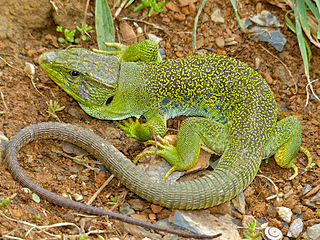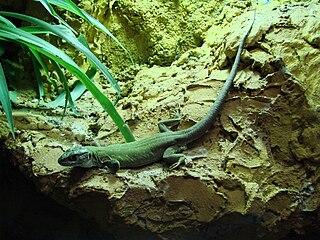
Timon of Athens is a play written by William Shakespeare and probably also Thomas Middleton in about 1606. It was published in the First Folio in 1623. Timon lavishes his wealth on parasitic companions until he is poor and rejected by them. He rejects mankind and goes to live in a cave.

The Lacertidae are the family of the wall lizards, true lizards, or sometimes simply lacertas, which are native to Europe, Africa, and Asia. The group includes the genus Lacerta, which contains some of the most commonly seen lizard species in Europe. It is a diverse family with at least 300 species in 39 genera.

Lacerta is a genus of lizards of the family Lacertidae.

Timon is a genus of wall lizards in the family Lacertidae.
The Lion King's Timon & Pumbaa, often simply referred to as Timon & Pumbaa, is an American animated buddy children's television series created by Walt Disney Television Animation. Based on the 1994 Disney animated film The Lion King, it centers on Timon the meerkat and Pumbaa the warthog, as they live their problem-free philosophy "Hakuna matata". Voice actors Ernie Sabella and Nathan Lane reprised their film roles as the title characters, with the latter voicing in only season 1.

The Lion King 1½ is a 2004 American animated adventure comedy film produced by the Australian branch of DisneyToon Studios and released direct to video on February 10, 2004. As the third installment released in the Lion King media franchise and the final installment in the trilogy, it serves as an origin story for the meerkat/warthog duo Timon and Pumbaa while the film is also set before, during and after the events of The Lion King. A majority of the original voice cast from the first film returns to reprise their roles, including Nathan Lane and Ernie Sabella as the voices of Timon and Pumbaa, respectively.

The ocellated lizard or jewelled lizard is a species of lizard in the family Lacertidae. The species is endemic to southwestern Europe.

Timon pater is a species of lizard in the family Lacertidae, the wall lizards. The species is endemic to Northwest Africa.

Timon princeps, commonly called the Siirt lizard or the Zagrosian lizard, is a species of lizard in the family Lacertidae. The species is endemic to Western Asia.
Timon and Pumbaa are an animated meerkat and warthog duo introduced in Disney's 1994 animated film The Lion King and its franchise. Timon was portrayed through his many appearances by Nathan Lane, Max Casella, Kevin Schon, Quinton Flynn, Bruce Lanoil in the Wild About Safety shorts and Kingdom Hearts II, and while Pumbaa is voiced by Ernie Sabella, and was portrayed by Tom Alan Robbins in the original cast of the Broadway musical. In the CGI remake, the characters are portrayed by Billy Eichner and Seth Rogen, respectively. Nathan Lane and Ernie Sabella first came to audition for the roles of the hyenas, but when the producers saw how well they worked together, they decided to cast them as Timon and Pumbaa.
Timon is a given name and surname. It may also refer to:

Timon tangitanus, commonly known as the Moroccan eyed lizard, is a species of lizard in the family Lacertidae. The species is endemic to Northwest Africa.

Arctostaphylos nevadensis, with the common name pinemat manzanita, is a species of manzanita.

Cupressus nevadensis, now reclassified as Hesperocyparis nevadensis, with the common name Paiute cypress, is a species of cypress tree native to a small area in Sierra Nevada of California, in the western United States.
Timon kurdistanicus, the Kurdistan lizard, is a species of lizard in the family Lacertidae. It is found in Iran, Iraq, and Turkey.











